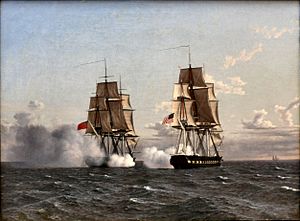Bibliography of 18th–19th century Royal Naval history facts for kids

This page helps you find amazing books and resources about the Royal Navy. The Royal Navy is the United Kingdom's powerful navy. These books cover its history during the 1700s and 1800s. You can learn about famous ships, brave sailors, and exciting sea battles. Some sources are "primary sources," which are like direct messages from the past. Others are historical accounts written by experts.
Contents
Learning about history is like being a detective. You look for clues in old books and documents. These sources help us understand how the Royal Navy became so important. They show us how ships were built and how sailors lived.
Many authors have written about the Royal Navy. Their books help us piece together its long story. For example, The War for All the Oceans by Roy and Lesley Adkins tells about big conflicts. Forests and Sea Power by Robert Greenhalgh Albion explains how important wood was for building ships.
Other books, like Joseph Allen's Battles of the British Navy, describe famous fights. Edward Archibald's The Wooden Fighting Ship shows how ships changed over time. These books are great for understanding the navy's journey.
Finding Original Stories (Primary Sources)
Some books are called primary sources. These are writings from people who were actually there! They might be letters, diaries, or official reports. It's like hearing history directly from the people who lived it. For example, some books about Admiral Nelson include his actual letters.
Many of these older books are now available online for free. They are marked with E'Book. This means you can read them on your computer or tablet.
The Royal Navy played a huge role in shaping history. It protected trade routes and defended the British Empire. Books like The Oxford Illustrated History of the Royal Navy by J.R. Hill give a big picture view. William Milbourne James wrote about the navy's challenges during the American Revolution.
Brian Lavery has written many detailed books. He explains how ships were built and armed. His books, like The Ship of the Line, show the amazing engineering of these old warships. Margarette Lincoln's Representing the Royal Navy looks at how the navy was seen by people.
Rif Winfield's books are like encyclopedias of British warships. They list designs, construction, and what happened to thousands of ships. These books are very helpful for anyone wanting to know specific details about ships from different time periods.
Horatio Nelson was one of the Royal Navy's most famous admirals. He was a brilliant leader and a true hero to many. Many books tell his life story and describe his incredible bravery.
Authors like Roger Knight and Ernle Bradford have written detailed biographies of Nelson. They explore his strategies and his impact on naval warfare. Peter Goodwin's Nelson's Ships focuses on the actual vessels he commanded.
Brian Lavery's Nelson's Navy gives a great overview of the navy during Nelson's time. It covers the ships, the sailors, and how everything was organized. You can also find books with Nelson's own letters and dispatches. These are primary sources that let you read his exact words.
Nelson's Big Battles
Admiral Nelson was known for winning important battles. Two of his most famous victories were the Battle of Copenhagen and the Battle of Trafalgar.
The Battle of Copenhagen (1801)
This battle took place in 1801. Nelson led the British fleet against the Danish-Norwegian fleet near Copenhagen. It was a tough fight, but Nelson's daring tactics led to a British victory. Books by James Stainer Clark and Ole Feldbæk give detailed accounts of this battle.
The Battle of Trafalgar (1805)
The Battle of Trafalgar happened in 1805. It was one of the most important naval battles in history. Nelson's fleet faced a combined French and Spanish fleet. Despite being outnumbered, Nelson's bold plan secured a decisive victory for Britain. Sadly, Nelson was mortally wounded during this battle.
Roy Adkins' Trafalgar: The Biography of a Battle tells the story of this epic fight. Edward Fraser's The Enemy at Trafalgar shares eyewitness accounts from both sides. Peter Warwick's Voices from the Battle of Trafalgar also uses firsthand stories. These books help us understand the bravery and chaos of that day.
See also
- List of naval battles
- List of Royal Navy ships
- List of ship names of the Royal Navy (a full historical list)
- List of early warships of the English navy
- List of ships captured in the 18th century
- List of ships captured in the 19th century
- List of frigate classes of the Royal Navy
- List of single-ship actions
- Glossary of nautical terms

